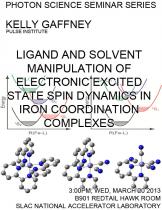Kelly J. Gaffney, PULSE Institute, SLAC National Accelerator Laboratory, Stanford University
Understanding the molecular properties that control the electronic excited state relaxation dynamics in transition metal based coordination complexes will be the subject of my seminar. Coordination complexes have many advantageous properties for solar energy applications, including strong visible absorption and photocatalytic activity. Whether used as a photocatalyst or a photosensitizer, the lifetime of optically generated electronic excited states represents a key metric. The earth abundance of the molecular components also represents a key metric for solar energy applications, and the dual need for long lived charge transfer excited states and earth abundance has undermined the usefulness of many coordination compounds. Isoelectronic iron and ruthenium based complexes represent a clear example. Ru-polypyridal based molecules have been the workhorse of solar energy related research and dye sensitized solar cells for decades, but the replacement of low abundance Ru with Fe leads to million-fold reductions in charge transfer excited state lifetimes.
Understanding the origin of this million-fold reduction in lifetime and how to control excited state relaxation in 3d-metal coordination complexes motivates our work at the LCLS. I will discuss measurements performed at the XPP endstation at the LCLS that used the spin sensitivity of hard x-ray fluorescence to track the impact of ligand field strength and solvent environment on the spin dynamics of a series of electronically excited [Fe(CN)6-2N(2,2’-bipyridine)N]2+2N-6 complexes, with N = 1-3. These femtosecond resolution measurements demonstrate that modification of the solvent and ligand environment can lengthen the Fe-bipyridal charge transfer lifetime by more than a factor of 120. They also verify the role of triplet ligand field excited states in the spin crossover dynamics from singlet to quintet spin configurations.





